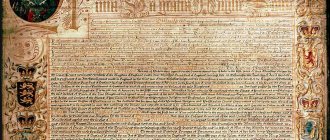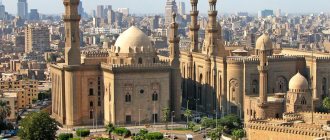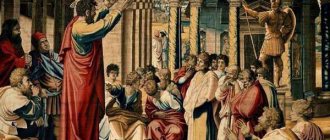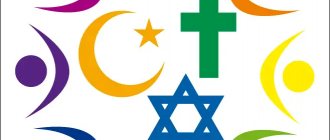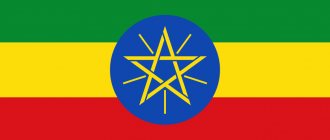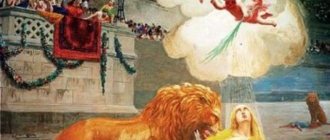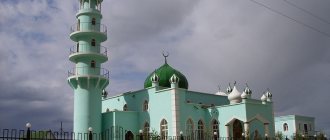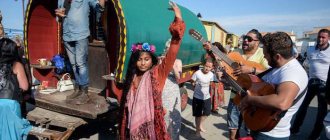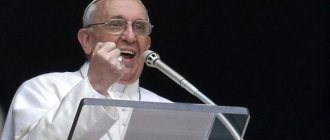When we think of France, the musketeers, Versailles, the Louvre, the Champs Elysees, Notre Dame Cathedral and the Sun King come to mind, eclipsing all earthly rulers with its brilliance. For many, France lies in its South Bank and Paris, and Paris itself has long been the most romantic city in the world, a city of lovers and artists.
Speaking about France, we remember five revolutions that destroyed the political system and changed the entire way of life of the French. But we think very little about which religion is dominant in this country.
Maybe because, as a result of revolutionary upheavals since the 17th century, the French believe in God less and less, and the number of atheists is steadily growing.
France is a Catholic country, but the French state is secular
You can find out which religion is most popular among the French from any tourist guide. Thus, according to the latest statistical studies, the majority of French people consider themselves Catholics. However, French legislation prohibits conducting a survey of religious affiliation. Thus, almost all data on the number of followers of a particular religion in the country can only be obtained from representatives of the religious organizations themselves.
Constitution of France. The French Constitution affirms the secular nature of the French state. Photo: upload.wikimedia.org
This situation has arisen because the French Republic is a secular state. Therefore, the question: what faith is considered the state faith among the French cannot be answered because it does not exist. Article 2 of the law of December 9, 1905 states:
“The Republic does not recognize, pay for or subsidize any religion. Accordingly, from January 1, after the entry into force of this Law, all expenses related to religion must be removed from the budget of the state, departments and communes. However, budget expenditures may include the services of a priest and the free exercise of religion in public institutions such as schools, colleges, hospitals, orphanages and prisons. State institutions of religion are abolished, subject to the provisions contained in Article 3.”
1905
from this year, church and state are separated in France, except for Alsace and Moselle
Since 1905, church and state have been officially separated throughout France, except for Alsace and Moselle, which did not belong to it at the time of the division. In 2004, a law was passed prohibiting the wearing of religious symbols in public schools (Law No. 2004-228 of March 15, 2004). On the night of September 15-16, 2011, a ban on prayers on the streets came into force in France.
For its implementation, the State allocated premises with an area of 2 thousand m² to the Muslim Association of the Parisian quarter Goutte d'Or (XVIII arrondissement) on a three-year lease at a fixed price of 30 thousand euros per year.
Le Monde newspaper. In France, it is prohibited to conduct opinion polls on religious affiliation. That is why the number of believers is estimated based on newspaper information. Photo: upload.wikimedia.org
As of 2015, according to the 2015 Le Monde newspaper from the French:
- 45% do not identify themselves with any religion.
- Catholics - 43%,
- Orthodox - 1%,
- Protestants - 2%.
- Muslims - 8%.
- Jews - 1%.
- Buddhists - 1%.
- Others - 1%.
Who's in the minority
A very small percentage of the French population among believers are Protestants, Buddhists and Jews. Protestants live mainly in northern France. Buddhism in France is the fourth largest religion in the world. In 1986, the Buddhist Union organization was founded, representing the interests of Buddhists. The Jews, who had lived in this European country since Roman times, were persecuted and largely exterminated during the Middle Ages. Today their situation is very unstable, and many emigrate to other countries.
Especially for Liliya-Travel.RU - Anna Lazareva
Orthodoxy appeared in France in the 1st century
Orthodoxy appeared on the territory of France in the 1st millennium AD. e. At that time, Orthodox parishes were part of a single Christian Church. After the schism of the Churches in the 11th century, the entire territory of France came under the jurisdiction of the Catholic Church. The first mention of the stay of a Russian Orthodox priest in Paris dates back to 1727. Then Priest Daniil Yakovlev arrived in Paris in France, accompanying the Russian envoy.
In 1738, at the request of the ambassador, a permanent priest, Priest Andrei Genevsky, was appointed. In 1757, a camp church corresponding to the level of the embassy was sent to Paris: “silver utensils, vestments made of expensive brocade,” an iconostasis on “blue satin with the best colors on gold.”
Orthodox Church of St. Nicholas the Wonderworker in Lyon. The Church of St. Nicholas was built by Russian emigrants. After the Russian Revolution and the Civil War, many Russian Orthodox Christians arrived from Russia to France. Photo: upload.wikimedia.org
The first Greek Orthodox parish in France was founded in 1820. In 1845, the consecration of the Greek Church of the Dormition of the Mother of God in Marseille, the first Orthodox church built in France, took place. In 1853, the first Romanian house church appeared in Paris.
The first religion of France was Orthodoxy.
According to the “Handbook of the Orthodox Church,” published in France, the number of Orthodox Christians in France in 2021 is about 500 thousand. Recently, there has been an increase in the number of Orthodox Christians in the country.
This is due to increased migration to France from traditionally Orthodox countries such as Russia, Greece, Serbia, Romania, Bulgaria and the Middle East. At the same time, mainly Orthodox Christians from Russia and Romania emigrate here. The number of Orthodox parishes in France for 2021 is 278, monasteries - 21, bishops - 10, priests and deacons - 330.
Russian wooden church of Epinay-sous-Senar. ROC. In France there are different jurisdictions of Orthodoxy. Photo: upload.wikimedia.org
Like many countries outside the territory of traditional Orthodoxy, France is characterized by the coexistence of a large number of jurisdictions, associated both with the different countries of origin of Orthodox believers and with the vicissitudes of the history of the 20th century. Today the country has the following structures:
- Patriarchate of Constantinople.
- Russian Orthodox Church.
- Serbian Orthodox Church.
- Romanian Orthodox Church.
- Antijochian Orthodox Church.
- Bulgarian Orthodox Church.
- Georgian Orthodox Church.
Catholicism
Catholicism, as one of the directions of Christianity, became autonomous from Orthodoxy after the Great Schism of 1054. The Catholic Church is the largest in Christianity in terms of the number of believers. This religion is widespread in many countries: mainly in Europe, but also in South and Central America, the USA, Cuba and Canada. Its teaching differs significantly from the dogma of other Christian denominations. In particular, Catholics do not have the right to dissolve a marriage, but they can declare it invalid. In the Catholic Church, the Virgin Mary is especially revered. In France, at least three cathedrals are dedicated to or related to the Virgin Mary:
- Notre Dame de Paris;
- Chartres Cathedral;
- Rouen Cathedral.
Catholics recognize the source of their doctrine as the Holy Scripture and Sacred Tradition, with which the concept of “Magisterium” is closely connected - the magisterium of the church, which provides for the service of the Word of God, but does not exceed it in importance.
The Seven Sacraments of Catholicism are:
- Baptism is the first and most important Christian sacrament, associated with immersion in water or dousing with water while the priest reads a special prayer;
- Confirmation is a sacred act recognized in all Christian churches, during which a person’s faith is strengthened;
- Confession is an admission before God of committing sins;
- Priesthood or ordination is the rite of initiation into the rank of deacon or elder; bishop is the highest rank in the Orthodox Church and only he can ordain a deacon or presbyter, the rest only help;
- Unction or unction, when the body of the believer is anointed with sacred oil;
- The Eucharist or the Lord's Supper is a sacred rite when the clergyman sanctifies bread and wine, and then it is given to the believers to taste;
- Marriage - Church wedding - means a union between a man and a woman, based on mutual respect and love for the purpose of creating a family and having children, concluded in the Church. It is believed that God himself blesses those married in the Church to a strong union and long life.
The Roman Catholic Church remained predominant for centuries and had a huge influence on the culture, mentality and traditions of the French. This is especially strongly expressed in holidays, most of which are religious: Christmas, Easter, Day of the Dormition of the Virgin Mary, Day of St. Barbara and others.
Catholicism and Protestantism fought for supremacy in France for a long time
The forerunners of Protestantism in France were the Waldensian and Cathar movements, which anticipated some of the ideas of the Reformation. The first Protestants appeared in France in the early 1520s. The ideas of the Reformation penetrated the country both from Germany and from French-speaking Switzerland. French authorities, who supported Catholics, persecuted Protestants, but the Huguenot community grew.
In 1562, after the Night of St. Bartholomew, which killed 30,000 Protestants, a series of wars began between them and Catholics. They ended 30 years later with the publication of the Edict of Nantes in France. He granted religious rights to the Huguenots.
"Huguenot on St. Bartholomew" (John Miele, 1852). A Catholic girl tries to put a white bandage on the arm of her Huguenot lover, signifying his commitment to Catholicism. The young man pulls off the bandage with the same hand with which he hugs the girl. During St. Bartholomew's Night in France, 30,000 Protestants died. Photo: upload.wikimedia.org
The Edict of Nantes was revoked by Louis XIV in 1658. Only in 1787, under Louis XVI, a new decree on religious tolerance was issued. Soon after this, Protestant churches were reopened.
Around 1580, the first community of the Anglican Church appeared in France. After the Thirty Years' War ended, Alsace became part of France. Along with him, Mennonites appeared in the country. Later they were joined by the Amish.
30 000
Protestants became victims of St. Bartholomew's Night
In 1938, part of the congregations broke away from the Reformed Church and created the National Union of Independent Evangelical Reformed Churches. In 2009, it became known as the National Union of Evangelical Protestant Reformed Churches of France.
In 1970, Madagascar students founded the Malagasy Protestant Church in France. In 2006, the Union of Protestant Churches of Alsace and Lorraine was formed. In 2013, after six years of negotiations, the Reformed and Lutheran churches created the United Protestant Church of France.
"The Apostle of the Gypsies" Clement Le Cossec, 1991. Protestantism is especially widespread among French gypsies (Pentecostals). Photo: upload.wikimedia.org
Nowadays, the Protestant religion in France is actively developing. So in 2010 there were 1.35 million Protestants in France. The proportion of Protestants among the French is very small.
A significant percentage of Protestants make up the Germans, English, Dutch, Americans, Swiss, Danes, Swedes, and Koreans living in France. A growing group of Pentecostal churchgoers are gypsies who have converted to Protestantism.
Gradual Islamization
In 2021, the French Ministry of Religious Affairs adopted a 4-year program to transfer Catholic churches to Muslim communities. The peak of the transfer of Christian religious buildings to imams occurred in 2021. In total, the authorities plan to give 52 Catholic churches for use to Muslims. The last of them will be transferred in 2022.
According to the Minister of Religious Affairs, M. Hariri, Christianity is an archaic religion, and an increasing number of French people understand this. The official expressed the hope that in no more than 50 years, Islam will be the predominant religion in France, and the transition will occur “naturally.”
Islam in France is the second largest religion in terms of number of parishioners and importance.
It is impossible to answer the question: what faith is popular in France without studying French Islam. The fact is that Islam is the second religion in France in terms of the number of adherents and importance and the first in terms of growth rates. The most important religious site for Muslims in France is the Paris Cathedral Mosque, founded in 1926 and now controlled by the Algerian authorities.
French colonial troops, Algeria. Colorization of our days. Islam began to develop in France after the First World War with the arrival of French colonial troops in the country. Photo: topwar.ru
Muslims appeared in France in 717, conquering Spain. To do this, they occupied Aquitaine and Narbonne in 719. In 888, the Arab colony of Fraxinet was founded in southern France and existed for almost 100 years. After this, Islam was absent from France for a long time. In the 19th - early 20th centuries, territories with a significant Muslim population - Algeria, Tunisia, Morocco - were annexed to France.
The largest influx of Muslims into the country occurred during the First World War. It was then that large numbers of North Africans were recruited to defend the country. In 1926, the Paris Cathedral Mosque was opened in memory of the Muslim soldiers who died in the First World War.
In France, wearing hijabs and any religious symbols is prohibited.
According to the head of the Muslim Council of France, Dalil Abu Bakr, in 2015 there were 7,200 mosques in France with 7,000,000 Muslims. Currently, there are several large Muslim public organizations operating in France. Since 1983, the Union of Islamic Organizations of France has been operating, which since 2014 has been included by the UAE authorities in the list of terrorist groups.
In 2003, the French Council for Muslim Worship was formed, in which, following the 2013 elections, Moroccan delegates predominate, but its head is the imam of the Paris Cathedral Mosque. In 2006, with the support of Morocco, the Association of French Muslims was created. Both organizations are connected to each other.
Paris Cathedral Mosque, 2014. The Paris Cathedral Mosque, the main religious building of French Muslims, belongs to the Algerian authorities. Photo: upload.wikimedia.org
Since the 80s of the 20th century, France has become characterized by increasingly widespread manifestations of Islamic religiosity on the part of immigrants and their children, and this was especially evident in schools, where Muslim girls came wearing traditional Muslim headscarves - hijabs.
On March 15, 2004, the country adopted a law on the secular nature of society. According to it, in government institutions and schools it is now prohibited to wear any signs demonstrating religious affiliation - large crosses, hijabs, turbans, Jewish kippahs or Sikh turbans. In January of the same year, there were massive anti-government demonstrations by Muslims protesting against this.
By leaving a comment, you accept the user agreement
Abbot Pierre
Speaking about Catholicism in France, one cannot ignore such a person, a Catholic, as Henri Antoine Groues, better known as Abbe Pierre. He died in Paris on January 22, 2007, and French newspapers were full of headlines that the most popular person in France had passed away.
Abbé Pierre really was one and ranked third in the ranking of “The Greatest Frenchmen of All Time” after Charles de Gaulle and Louis Pasteur, although Henri Groues himself was skeptical about his popularity. Despite the fact that he was born into a wealthy family and could choose any career, he already at the age of 19 realized that serving God was his only calling.
It was Grues who founded the Emmaus charity. With his own funds, he bought a house on the outskirts of Paris, and with the help of volunteers, he restored it, and then set up a shelter there for the destitute and orphans. “Emmaus” was the name of the Palestinian village where the disciples met the risen Savior. Grues gave this name to his shelter. Today Emmaus exists in 43 states where homeless and unemployed people live. They receive a minimum wage for doing simple work.
Henri Grues was a man who was not indifferent to the troubles of others. He was especially concerned about orphans, beggars, and persecuted by society. Thus, during the Second World War, he helped Jews cross the Swiss border. It was then that his underground “nickname” appeared - Abbé Pierre, which later became his middle name.
Grues was awarded many times and was even nominated for the Nobel Peace Prize. He said to himself: “In order to do something outstanding, you don’t have to be an outstanding person yourself.”
Then, in January 2007, a farewell funeral service took place at Notre Dame Cathedral. 25 thousand people came to say goodbye to the man of Peace - Abbot Pierre, who went on his “Great Holiday”.
Sacre Coeur
The Sacré-Coeur Basilica is one of the most famous churches in Paris. It is highly visited due to its location on a hill overlooking the famous Montmartre district. The church was designed in the Roman-Byzantine style, and is very similar to the famous Hagia Sophia in Istanbul. One of the main features of Sacre Coeur is the huge mosaic of Jesus with a heart of gold.
Photo: pixabay.com (CC0 Creative Commons)
Photo: (CC0)
Photo: pixabay.com (CC0 Creative Commons)
Monolithic Church of Saint-Jean
The town of Aubterre-sur-Dronne is small and picturesque, with traditional architecture and quaint houses. But the city's most incredible attraction is located underground. This is a monolithic Saint-Jean church, almost entirely carved from limestone. It was built in the 7th century and significantly expanded in the 12th century. The church has a vaulted nave, a baptismal pool and dozens of ancient burial grounds. Although this is far from a traditional French church, it is truly unique and one of a kind.
Photo: (CC BY-SA 4.0)
Photo: (CC BY-SA 4.0)
Photo: (CC BY-SA 4.0)
The War of the Three Henrys: the finale
In 1584, the king's brother Francis of Alençon, the last direct heir to the French throne, passed away. Henry III had no children and Henry of Navarre became a likely contender for the throne. This situation outraged the league: supporters of Henry Guise turned to the Spanish king Philip II for help. The Edict of Nemours of the same year, issued by the king under pressure from the Guises, again outlawed the Huguenots, but did not abolish Henry of Bourbon’s rights to the throne.
Elizabeth I Tudor. Source: pinterest.ru
The main hostilities began only in 1587. Henry of Navarre received generous help from his “brothers in faith”: the English Queen Elizabeth I sent him a large sum of money, with which the Huguenots were able to hire a large army of German Protestants. The military operations of the Huguenots proceeded with varying success: Henry of Navarre defeated the royal units at Coutras, but the German mercenaries were defeated by Guise at Vimory.
Heinrich Giese. Source: pinterest.ru
Henry III lost influence in the capital: the “Day of the Barricades” in May 1588 forced him to flee Paris. The king also began to seek an alliance with the Huguenots. On December 23-24 of the same year, being in a difficult situation and having accepted all the demands of the Ligists, the king gave the order to kill Heinrich of Guise and the Cardinal of Lorraine. On May 15, 1589, the Estates General was dissolved. But on August 1, the king was killed by an agent of the league, the monk Clement.
Henry of Navarre, who was in Normandy at that moment, declared himself the new king of France.
The Ligists put forward their candidacy for the French throne in the person of Cardinal Charles X of Bourbon. The victory of Henry of Navarre remained a matter of time. The Huguenots, led by Henry IV, defeated the troops of the new head of the League, the Duke of Mayenne, at the battles of Arc on September 21, 1589 and Ivry on March 14, 1590. Protestants also besieged Paris twice.
Saint-Michel d'Aiguille
Getting to Saint-Michel d'Aiguille is quite difficult. This amazing church is located on a cliff and you have to climb 268 steep steps carved into it. However, the efforts made will not be in vain. You will have the opportunity to see the sacred stone building, built in the mid-10th century. The church looks stunning from below, but once you get to the top you can admire the magnificent landscape and the city of Egil.
Photo: pixabay.com (CC0 Creative Commons)
Photo: (CC BY-SA 4.0)
Photo: (Public domain)
Marian apparitions[edit]
Several Marian apparitions are associated with France. The most famous are the following:
- Our Lady of the Rosary, associated with Dominic de Guzman in Prouil
- Our Lady of Lourdes, associated with Bernadette Soubirous at Lourdes
- Our Lady of La Salette, associated with Maxime Giraud and Mélanie Calvate in La Salette-Fallavo
- Medal of Our Lady of the Miraculous, associated with Catherine Labourg on Rue du Bac, Paris
- Our Lady of Laus, associated with Benoît Rencourel in Saint-Étienne-le-Laus
- Our Lady of Pontmain, associated with Joseph and Eugene Barbedette at Pontmain
- Our Lady of Pellevoisin, associated with Estelle Faguette in Pellevoisin
Is secularism the “cornerstone” of the state?
Secularism is today considered the “cornerstone” of French state self-determination. Compared to Great Britain or the USA, the importance of religion in the life of the society of the state in question is very insignificant. In the UK and US, politicians often organize meetings with religious leaders, take photographs with them at official receptions, and many important national events and activities are preceded by religious ceremonies. But in France everything is different. Public figures of this secular state, even if they call themselves Christians (which is becoming less and less popular among government members nowadays), try for various reasons to hide their religious life from prying eyes.
French people
The main vital concern of the French is to be true French.
Michelle Sirette
The French treat all other representatives of the human race condescendingly, because people are simply unlucky that they were not born French. The French consider themselves true experts in everything that seems important to them, and if they are not knowledgeable in some area, then it is most likely nonsense that has no meaning.
The national hero for a true Frenchman is Cyrano de Bergerac, a poet and warrior (alas, burdened with a serious physical disability), as well as Gerard Depardieu, who played Cyrano in the movies. In general, the French like “stars” who rose from the very bottom thanks to their own efforts.
French women
French women and elegance are almost synonymous. French women look so that men feel the need to give them a seat on the subway, carry their luggage and open all doors for them. French women are accustomed to worship, accustomed to listening to compliments on any occasion, and the French are accustomed to giving them.
French women are always ready for a little flirtation. If a man makes no attempt to seduce his interlocutor, she may even be slightly upset. What is the point of buying stylish clothes, demonstrating a sharp mind and refined manners, if a man refuses to play the role assigned to him by nature?
And, by the way, look at the symbol of France, Marianne, whose image in recent years has been modeled on Brigitte Bardot, Mireille Mathieu, Catherine Deneuve, Patricia Kaas and Laetitia Casta.
Strasbourg Cathedral
Strasbourg Cathedral is sometimes called the Pink Cathedral, alluding to its unusual hue. The cathedral is built from sandstone, which gives it its pink color. On one side of the building there is a tall spire, although according to the design there should have been two. The architecture is both Romanesque and Gothic. Services are still held in the cathedral, which you can visit. Inside, be sure to find the astronomical clock, which dates back to the 19th century.
Photo: pixabay.com (CC0 Creative Commons)
Photo: pxhere.com (CC0 Public Domain)
Photo: (CC BY-SA 3.0)
Christian quotes and aphorisms on various topics Telegram
During the French Revolution, Christianity came under severe threat. It was shocked and shaken by the stormy onslaught of persecution, it bent under the pressure and, perhaps, it would have been uprooted if this pressure could have continued.
Under the “old order” (under the king) in pre-revolutionary France, the clergy had a privileged position as the First Estate, very closely associated with power.
The “Church” at that time mainly meant the Catholic Church. However, both Protestant churches in France, Lutheran and Reformed, were affected by the anti-religious movement of 1793 and II. It was all of Christianity, and not just Catholicism, that was under attack at this moment, when the new France was being born.
During the Revolution, the church became the target of persecution by the state.
